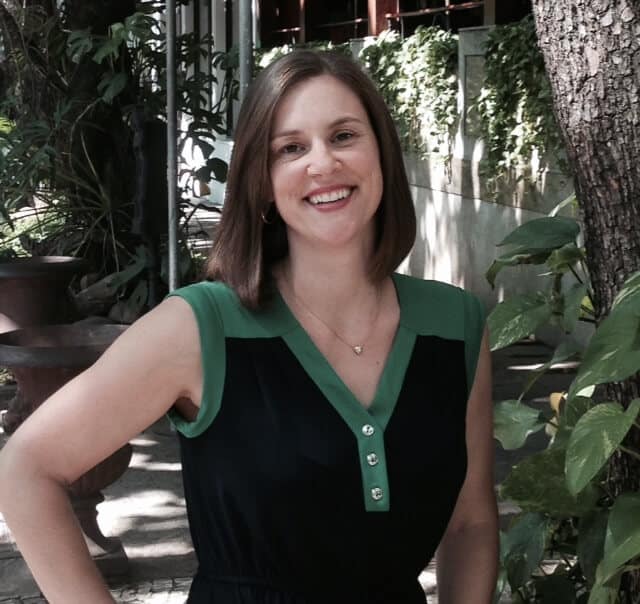Written by Elizabeth Clarkson, Ed.D
When I was teaching PreK, getting our children in and out of the lunch room was usually a struggle; it was crowded and a little too loud for us. As soon as the weather warmed up we’d beeline to the playground picnic tables with our milk cartons and trays. During our unit on transportation we handed the cafeteria worker our “ticket,” climbed aboard our imaginary Lunch Bus, and sang “Wheels on the Bus” all the way down the hall toward the playground.
We enjoyed our chats about the passing cars and trucks that we noticed while eating together outside. These lunch adventures, along with many other fun activities and explorations, were regular events in my classroom and made up the bulk of my lesson plans. Back then, my units were more thematic in nature ranging from transportation and animals to seasonal events and celebrations. My classroom was engaging, lively, and generally a happy place.
Even with all the fun we were having, now thinking back to my early teaching days, I wonder: “Did I really plan at the unit level or was my unit really a collection of monthly lesson plans?” Could I really articulate the big picture with enduring understandings, specific content, and skills on a unit level and how they connected throughout the year and into the next year?
My director was eager to see my lesson plans and I dutifully produced these documents, including songs we would sing and crafts for us to enjoy. I was planning weekly activities, and while they were fun and engaging, they were not connected to a larger academic/cognitive, social, or even program goal. Most often, the units followed the holiday calendar—pumpkins in October, turkeys at Thanksgiving, hearts in February, etc. “Now wait a minute,” you think, “fall themes are a staple in ECE classes and everyone loves turkeys in the shape of handprints!” While I’m not advocating for pre-school days devoid of seasonal crafts, I think it’s essential to examine how we build these plans and the best ways to identify and support our larger goals.
Looking back, I can see my idea of writing a unit plan was focused on the lesson plan level and I wasn’t paying enough attention to the bigger picture. I wasn’t even sure what the “bigger picture” was. There are so many components in high quality early education. I wondered: Did I really have to write down everything? The lists would be endless! Consider this for a minute: teachers should plan at the unit level to focus on standards/topic alignment, enduring understandings, essential questions, and content/skills and then build lesson plans that turn those elements into manageable, logical, and lively experiences that consider a specific period of time.
Unit goals should drive lessons plans, not the other way around.
With that structure in mind, let’s think about what elements are better suited for a unit plan and which ones are better served in a lesson or daily planning document.
| Unit Plans – Transportation | Lesson Plans - Transportation |
| Standards, Outcomes, Benchmarks, Goals, etc. (if appropriate to your school) | Times of day and daily routines
|
Enduring Understanding:
| Specific center/circle time elements
|
Essential Question
| Individual center activities and any necessary materials, including modifications
|
Content related to the standard or theme:
| Particular small groups of children and their focus activity |
Skills related to the standard or theme:
| Specific songs or books you plan to read that day
|
Vocabulary words specific to the theme you would like to introduce and reinforce:
| Specific vocabulary words that can be naturally introduced during a story
|
Crafts or specific projects, including supplies and modifications
|
Remember, start at the unit level and consider your goals and enduring understandings (big ideas) first. Lessons and activities should describe what students are doing during the day to explore, investigate, and discover these big pictures in learning. Consider asking yourself these questions and be open to using the answers in different ways when creating a written curriculum for your program.
- Instead of...What larger goal do these activities support? Ask… What activities support our broader concepts?
- Is there a strong connection between the larger concept and the activity on the lesson plan?
- Am I keeping the bigger picture and goals constant and adjusting my activities so my lesson plans support, but don’t drive, my unit planning?
Perhaps you are one of many teachers with giant binders full of fantastic activities that your students love. Does that mean you need to start from scratch when you begin mapping your curriculum? Definitely not! Your collection of resources you’ve curated over the years, shared with colleagues and painstakingly created yourself are invaluable! Let those collections of activities and crafts bring the larger goals to life in age-appropriate and creative ways!
Early childhood classrooms are vibrant places—full of wonder, laughter, and joy. They should be spaces that allow children to practice their cognitive and non/academic skills in safe, nurturing places. Teachers and students should enjoy each others’ company, have fun together during those outdoor picnics! But these intentional and rich learning spaces don’t happen by accident. With careful planning, the result can be magical.
 Dr. Elizabeth Clarkson began her career in North Carolina public schools. After living in several other countries, she now considers North Carolina her home again. She has worked as a teacher, literacy coach, and principal in public and private schools in the United States, Ecuador, and Brazil. She combines her experiences in schools and nonprofit education to view all education conversations within the larger context of community, its values, and influences. She continues to draw from her experiences in academic coaching and international living to support schools in developing strong curriculum processes that support their unique values and identities.
Dr. Elizabeth Clarkson began her career in North Carolina public schools. After living in several other countries, she now considers North Carolina her home again. She has worked as a teacher, literacy coach, and principal in public and private schools in the United States, Ecuador, and Brazil. She combines her experiences in schools and nonprofit education to view all education conversations within the larger context of community, its values, and influences. She continues to draw from her experiences in academic coaching and international living to support schools in developing strong curriculum processes that support their unique values and identities.

